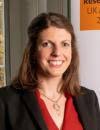This is the third in a series of quick fire interviews with Ingenious Women alumni. The Ingenious Women programme has been running in Scotland for eight years and over 130 women have been on the programme.

Dr Sarah McGlasson
Postdoctoral researcher
UK Dementia Research Institute, University of Edinburgh
1) Please describe your professional background and current role.
Response:
I got my PhD in human genetics in 2015 and since then have been a postdoc gradually moving into neurovascular science and applying genetics and molecular biology to (attempt to) solve problems of human disease. I feel constantly out of my depth in a neuroscience department but looking at questions from a different angle that a neuroscientist may not have thought about!
2) Why did you apply to the IWS programme?
Response:
I really struggled with the PhD to postdoc transition – which also coincided with life changes (I think this is often the case). I felt really lost for a couple of years without the structure and deadlines of a PhD, and any self-belief I had disappeared. I knew I needed to push out of my comfort zone and I applied to the IWScot programme looking for some fresh perspectives and some constructive ideas about how to develop myself and my career.
3) What did you take away from the IWS programme?
Response:
The women that I was lucky enough to go through this programme with are the most inspiring bunch and we have developed a very supportive network – which is absolutely invaluable. It has also pushed me to go on to develop other networks further as it has shown me that a diverse group of networks are really important in career progression and for personal support.
4) What has been the highlight of your career so far?
Response:
This is going to sound a bit daft but the highlight has actually been the fact that I’ve made it this far! There have been so many times that I’ve thought that I’m not cut out for it, and not good enough to keep up, but I’m proud of my stubborn streak that doesn’t let me give up!
5) What three career recommendations would you give to early career researchers?
Response:
- Surround yourself with good, kind people that inspire you and build you up.
- Don’t compare your insides to other people’s outsides – everyone is fighting a private battle and everyone is trying to put a good face on it.
- Enjoy what you do – at least the bigger picture. There are a lot of challenges but the enjoyment has to outweigh it!
